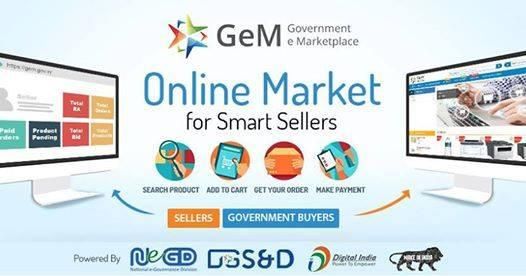E-Marketplace Gem 3.0
May 15, 2019 • 42 views
About GEM:
The Ministry of Commerce & Industry has launched third version of the Government e-Marketplace (GeM 3.0)in Jan 31 2018.The earlier version GeM 2.0 was launched as pilot project in August 2016.
GeM 3.0 will offer standardised and enriched catalogue management, powerful search engine, real time price comparison, template-based Bid and RA creation, demand aggregation, e-EMD, e-PBG, user rating, advanced MIS and analytics and more.
GeM is an Online Market platform to facilitate procurement of goods and services by various Ministries and agencies of the Government. It has been envisaged as National Procurement Portal of India

What is its aim?
It aims to enhance transparency, efficiency and speed in public procurement of goods and services and eliminate corruption. It functions under Directorate General of Supplies and Disposals (DGS&D), Ministry of Commerce and Industries. It is completely paperless, cashless and system driven e-market place that enables procurement of common use goods and services with minimal human interface.
It has powerful search engine and price comparison using third party sites – multisource and real time. It has performance based User Rating and online vendor assessment. It has market based-bundling and bunching of products and services. It also has multi-Cart Functionality and offers more Services with bid and RA Facility.
Benefits of GEM:
Completely transparent transactions across all ranges.
Market Based generic requirements across all government agencies.
Open and dynamic market place with rating based on performance of user on website.
Generic standards established through universal service levels and cost comparison enabled.
Standardisation of specifications of both products and services enabling empirical price comparability.

Benefits so far
The platform has successfully provided access to more than 4.2 lakh products, using a network of over 1.3 lakh sellers and service providers. These products are being bought by over 25,000 Indian government organisations registered on the platform.
Few top-selling product categories are photocopiers, computers, automobiles and office furniture. Some popular services transacted are human resources, transport, security, digitisation and cleaning. There have been many other benefits that are derived through this platform over the past two years. For instance, more than 40 per cent of transactions is done with MSMEs (micro, small and medium enterprises) registered on the platform, hence promoting the growth of small scale businesses. In July 2017, Indian Industries Association (IIA) and Government-e-Marketplace (GeM) had signed a bilateral MoU agreement to facilitate MSMEs and provide them assistance for registration and transactions through the GeM portal.
22 States have signed a formal MoU with GeM to adopt GeM as the core procurement portal in their respective territories. These are Gujarat, Jharkhand, Telangana, Uttar Pradesh, Andhra Pradesh, Assam, Manipur, Arunachal Pradesh, Bihar, Tamil Nadu, Tripura, Punjab, Haryana, Madhya Pradesh, Chhattisgarh, Nagaland, Himachal Pradesh, Uttarakhand, Odisha, Maharashtra, Meghalaya and West Bengal. Statistics so far suggest that the use of the GeM portal has resulted in an average savings of 25 per cent for its users.
Training of over 40 thousand buyers and sellers has been conducted across 28 States & UTs to enable them to seamlessly operate the platform. Integration with Quality Council of India (QCI) for ensuring quality compliances of the products and services offered through GeM.
Recently, GeM launched a service for the original equipment manufacturers (OEM) of the goods that are procured through the portal to help them track the movement of their products. While designated dealers who bid for government contracts were the only ones supplying to the government entities during the DGS&D days, e-marketplace has allowed every dealer or vendor of OEMs to participate in the bid.
Rating System
To further improve the procurement process, the GeM has recently introduced a rating system for its buyers and sellers. The move will improve transaction efficiency, as buyers will rate government agencies on the basis of their treatment towards their suppliers.
"If a government agency does not pay on time, rejects orders unnecessarily, does not close its order on time, the pre-set algorithm would downgrade its rating. Similarly, if the seller makes an offer but fails to deliver, or delivers late, or gets rejected for genuine reasons, its ratings get hit," says Ms Chauhan.
At the same time, the GeM has also introduced a review system that allows government departments to track the progress of the procurement process regularly. Over the past two years, the average payment cycle has gone down from 3-4 months to 23 days. The aim is to further bring it down to 10 days. This has been achieved due to the online transparency in monitoring the payment process status.
Conclusion:
Thus it aims to enhance transparency, efficiency and speed in public procurement of goods and services and eliminate corruption.
